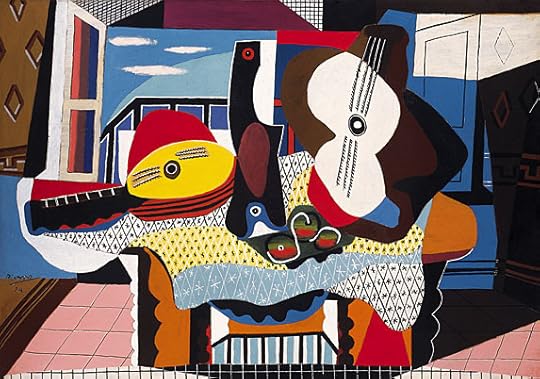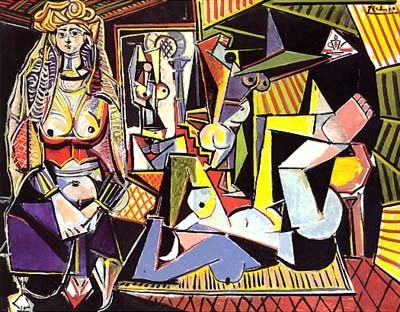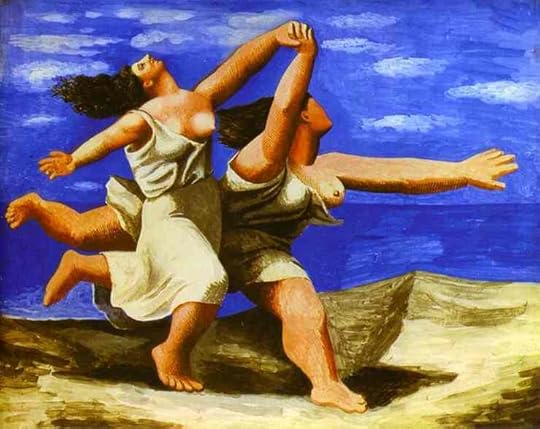Art Lovers discussion
Introduce an Artist and/or Work
>
Lets talk Picasso!
date newest »
newest »
 newest »
newest »
 thanks for the comment, Jillian. I do like some of Picasso's earlier works before the cubism. Sometimes I don't 'get' why the cubism, Ii guess I need it to be brought to my attention,.,
thanks for the comment, Jillian. I do like some of Picasso's earlier works before the cubism. Sometimes I don't 'get' why the cubism, Ii guess I need it to be brought to my attention,.,
 ""The art of painting original arrangements composed of elements taken from conceived rather than perceived reality."
""The art of painting original arrangements composed of elements taken from conceived rather than perceived reality."-- Guillaume Apollinaire, The Beginnings of Cubism, 1912.
I especially like this one:

Blue Nude
I'm not a big Picasso fan as far as his chauvinistic personality. But I do enjoy his work. Personally, I like his earlier work better than his cubist paintings, but there are some works that he introduced to cubism that I enjoy.

Girl with Mandolin

Mandolin and Guitar

Women of Algiers after Delacroix
The Spanish artist Juan Gris, b. Mar. 13, 1887, d. May 11, 1927, was, with Pablo Picasso and Georges Braque, one of the first and greatest exponents of the cubist idiom in painting.

Picasso
Juan Gris
 a few quotes -- "Inspiration exists, but it has to find us working."
a few quotes -- "Inspiration exists, but it has to find us working." "You have to have an idea of what you are going to do, but it should be a vague idea."
I have to say that I pretty much love the majority of his work. I was blown away when I went to see his Retrospective at MoMA in 1980. The Guernica is amazing! It's size and power as you walked up the stairs (now they have escalators) was overwhelming.
My favorites are --
[image error]
Les Demoiselles d'Avignon, 1907, 8' x 7' x 8", oil on canvas, MoMA
Picasso drew on sources as diverse as Iberian sculpture, African tribal masks, and El Greco's painting to make this startling composition.
[image error]
The Guernica, 1937, 137.4 in x 305.5 in., oil on canvas, Reina Sofia Museum in Madrid
[image error]
Girl before a mirror, 1932, oil on canvas, 64 x 51, MoMA
Girl Before a Mirror shows Picasso's young mistress Marie-Thérèse Walter, one of his favorite subjects in the early 1930s. Her white-haloed profile, rendered in a smooth lavender pink, appears serene. But it merges with a more roughly painted, frontal view of her face—a crescent, like the moon, yet intensely yellow, like the sun, and "made up" with a gilding of rouge, lipstick, and green eye-shadow. Perhaps the painting suggests both Walter's day-self and her night-self, both her tranquillity and her vitality, but also the transition from an innocent girl to a worldly woman aware of her own sexuality.
It is also a complex variant on the traditional Vanity—the image of a woman confronting her mortality in a mirror, which reflects her as a death's head. On the right, the mirror reflection suggests a supernatural x-ray of the girl's soul, her future, her fate. Her face is darkened, her eyes are round and hollow, and her intensely feminine body is twisted and contorted. She seems older and more anxious. The girl reaches out to the reflection, as if trying to unite her different "selves." The diamond-patterned wallpaper recalls the costume of the Harlequin, the comic character from the commedia dell'arte with whom Picasso often identified himself—here a silent witness to the girl's psychic and physical transformations. --MoMA
[image error]
Portrait of Dora Maar, 1937, Musee Picasso, Paris
[image error]
Tumblers (mother and son), 1905, gouache on canvas, Staatsgalerie, Stuttgart, Germany
[image error]
Portrait of Sylvette, 1954, Oil on canvas, Private collection
[image error]
Portrait of Paul Picasso as a child, 1923, oil on canvas, Collection of Paul Picasso, Paris, France
[image error]
The Dream, 1932, oil on canvas, Private collection
 WOW, The Guernica IS insane! Love it! And the Girl Before A Mirror is fun to 'watch.' :)
WOW, The Guernica IS insane! Love it! And the Girl Before A Mirror is fun to 'watch.' :) I'm getting lost in a lot of these paintings... I think I've found a muse! haha... It's about time that I take a good look into his work!
 jillian wrote: "WOW, The Guernica IS insane! Love it! ..."
jillian wrote: "WOW, The Guernica IS insane! Love it! ..."One of my favorite things about the painting is that although it is all in black and white and grey, he did all kinds of tricks like different whites, white over black, black over white, letting the under paint show though, so the neutrals all have a subtle range from warm to cool, and a lot of variation,which you really can't see in reproduction.
 I dont care for cubism in general but The Dream is nice. I do like His Hands with Bouquet from 1958 as well
I dont care for cubism in general but The Dream is nice. I do like His Hands with Bouquet from 1958 as well
 Apple Owes It All to Picasso
Apple Owes It All to PicassoBy Alex Eichler
Here's what we know: On December 16, 2009, the Italian blogger Cattani Simone visited the Contemporary and Modern Art Museum of Trento and Rovereto, where a painting by Pablo Picasso caught his eye. The painting, a 1934 work called Two Characters, leapt out at Simone because of a part that looks like this:

This reminded Simone of the Mac Finder icon, which looks like this:
And now, people are asking whether the painting influenced the look of the icon. That remains unclear, but here's what else we know: Apple has taken design cues from Picasso before. Gizmodo's Jesus Diaz points out that "the original Mac icon... was nicknamed the Picasso Mac," and that the designers, Tom Hughes and John Casado, were "inspired" by the Spanish painter. (The Apple Museum calls this "probably the most popular logo.") Here's what that logo looks like:

Picasso's supposed line about how "good artists copy, great artists steal"
These, ladies and gentlemen, are the facts. Now it's left for you to judge: Does all of this prove that Pablo Picasso wrote the OS for the iPhone during his Blue Period, and Steve Jobs time-traveled back to 1902 and stole it from him? We can't say that it does. But we can't say that it doesn't.
 There is a Picasso exhibit coming to San Francisco this summer. I'd love to read a book about him before it comes. Can anyone recommend something?
There is a Picasso exhibit coming to San Francisco this summer. I'd love to read a book about him before it comes. Can anyone recommend something?
 It depends what you're looking for, but the best biography of Picasso--maybe one of the best biographies of any artist--is John Richardson's A Life of Picasso: Volume I, 1881-1906. It's quite long (there are two additional volumes and another on the way) but remarkably well-written, intelligent, and engaging.
It depends what you're looking for, but the best biography of Picasso--maybe one of the best biographies of any artist--is John Richardson's A Life of Picasso: Volume I, 1881-1906. It's quite long (there are two additional volumes and another on the way) but remarkably well-written, intelligent, and engaging.
 I have too many books on Picasso. I am not familiar with the book Jonathan recommends but it appears to have good reviews. I would recommend these three:
I have too many books on Picasso. I am not familiar with the book Jonathan recommends but it appears to have good reviews. I would recommend these three:Portrait of Picasso by Roland Penrose –short book - 124 pp.; 1971, MoMA. An overview of his life/work/relationships; many photos and artworks.
http://www.goodreads.com/book/show/46...
 Picasso by Carsten-Peter Warncke – 240 pp. Taschen 2001.
Picasso by Carsten-Peter Warncke – 240 pp. Taschen 2001.I enjoyed this book. It's the most comprehensive book I have on Picasso's life and artwork. It is a large book: 9 1/2” x 12” with beautiful color plates of ALL his work as well as many, many photos. Chronology at the back of the book. I bought it at Borders for little $. http://www.goodreads.com/book/show/10...
 Picasso’s Mask by Andre Malraux, 1974, Edition Gallimard -- contains only a few photos. http://www.goodreads.com/book/show/10...
Picasso’s Mask by Andre Malraux, 1974, Edition Gallimard -- contains only a few photos. http://www.goodreads.com/book/show/10...
 If anyone is near Richmond Va. This exhibit just opened. It's a major coup for the Virginia Museum of Fine Arts. It's only stop on the East Coast! This maybe the one going to SF, Kara.
If anyone is near Richmond Va. This exhibit just opened. It's a major coup for the Virginia Museum of Fine Arts. It's only stop on the East Coast! This maybe the one going to SF, Kara.
http://www.vmfa.state.va.us/Picasso/
 Jonathan wrote: "It depends what you're looking for, but the best biography of Picasso--maybe one of the best biographies of any artist--is John Richardson's A Life of Picasso: Volume I, 1881-1906. It..."
Jonathan wrote: "It depends what you're looking for, but the best biography of Picasso--maybe one of the best biographies of any artist--is John Richardson's A Life of Picasso: Volume I, 1881-1906. It..."They are out, I read them. They are good too.
 Yes, the three volumes that have been published so far are very good. The fourth volume is expected for next fall.
Yes, the three volumes that have been published so far are very good. The fourth volume is expected for next fall.
 Thanks for all the suggestions. Lorie, is the exhibit in VA from the Picasso Museum in Paris? That's the exhibit coming to SF.
Thanks for all the suggestions. Lorie, is the exhibit in VA from the Picasso Museum in Paris? That's the exhibit coming to SF.
Books mentioned in this topic
A Life of Picasso, Vol. 1: The Early Years, 1881-1906 (other topics)A Life of Picasso, Vol. 1: The Early Years, 1881-1906 (other topics)



Here's some great Pablos, not all the same style:
http://artnews.org/gallery.php?i=1263...
http://en.wikipedia.org/wiki/File:Gar...
http://en.wikipedia.org/wiki/File:Pic...
*ONE OF MY MOST FAVORITE PAINTINGS OF ALL TIME:
http://www.voorhees.k12.nj.us/6957010...